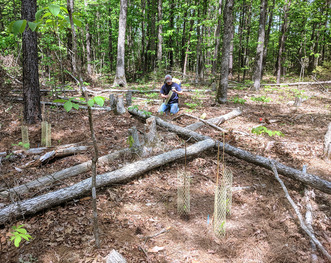- Record: found
- Abstract: found
- Article: found
Effects of drought, disturbance, and biotic neighborhood on experimental tree seedling performance

Read this article at
Abstract
Forest biodiversity is likely maintained by a complex suite of interacting drivers that vary in importance across both space and time. Contributing factors include disturbance, interannual variation in abiotic variables, and biotic neighborhood effects. To probe ongoing uncertainties and potential interactions, we investigated tree seedling performance in a temperate mid‐Atlantic forest ecosystem. We planted seedlings of five native tree species in mapped study plots, half of which were subjected to disturbance, and then monitored seedling survival, height growth, and foliar condition. The final year of data collection encompassed a drought, enabling comparison between intervals varying in water availability. Seedling performance was analyzed as a function of canopy cover and biotic neighborhood (conspecific and heterospecific abundance), including interactions, with separate generalized linear mixed models fit for each interval. All species exhibited: (a) pronounced declines in height growth during the drought year, (b) detrimental effects of adult conspecifics, and (c) beneficial effects of canopy openness. However, despite these consistencies, there was considerable variation across species in terms of the relevant predictors for each response variable in each interval. Our results suggest that drought may strengthen or reveal conspecific inhibition in some instances while weakening it or obscuring it in others, and that some forms of conspecific inhibition may manifest only under particular canopy conditions (although given the inconsistency of our findings, we are not convinced that conspecific inhibition is critical for diversity maintenance in our study system). Overall, our work reveals a complex forest ecosystem that appears simultaneously and interactively governed by biotic neighborhood structure (e.g., conspecific and/or heterospecific abundance), local habitat conditions (e.g., canopy cover), and interannual variability (e.g., drought).
Abstract
Forest biodiversity is likely maintained by a complex suite of linked variables. To probe ongoing uncertainties and potential interactions, we investigated tree seedling performance via a multi‐year, manipulative field experiment. Our work reveals a complex temperate forest ecosystem that appears simultaneously and interactively governed by biotic neighborhood structure (e.g., conspecific and heterospecific abundance), local habitat conditions (e.g., canopy cover), and interannual variability (e.g., drought).
Related collections
Most cited references67
- Record: found
- Abstract: not found
- Article: not found
Herbivores and the Number of Tree Species in Tropical Forests
- Record: found
- Abstract: found
- Article: not found
Pathogens and insect herbivores drive rainforest plant diversity and composition.
- Record: found
- Abstract: found
- Article: not found

